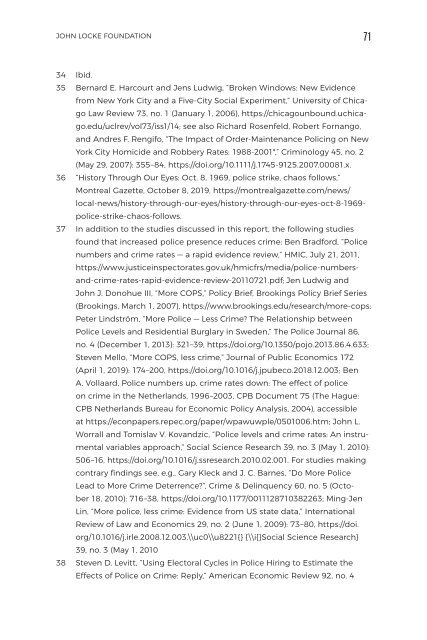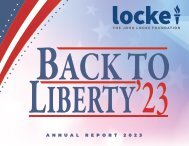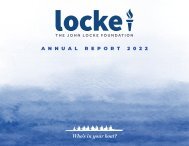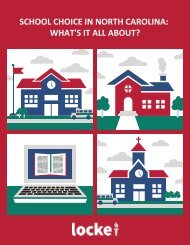Keeping the Peace Through Intensive Community Policing
As crime soars and the breakdown of public order takes its toll on our country, analysis from the John Locke Foundation signals it’s time to adopt a different approach to crime control, one that shifts the focus further upstream, looking at prevention models, rather than exclusively on punitive measures. In this July 2021 report, John Locke Foundation researcher and author Jon Guze explains that the current focus of catching, convicting, and punishing perpetrators after crimes have been committed has come with enormous economic and social costs. However, intensive community policing has proven successful at deterring crime and maintaining order, which leads to safer communities and fewer people living in poverty. Guze recommends a four-pronged plan to move forward with community policing: (1) hire more police officers (2) increase the pay for police officers (3) arm police officers with state-of-the-art training, direction, and support (4) deploy police officers as “peacekeepers” in communities that suffer most from crime and disorder.
As crime soars and the breakdown of public order takes its toll on our country, analysis from the John Locke Foundation signals it’s time to adopt a different approach to crime control, one that shifts the focus further upstream, looking at prevention models, rather than exclusively on punitive measures. In this July 2021 report, John Locke Foundation researcher and author Jon Guze explains that the current focus of catching, convicting, and punishing perpetrators after crimes have been committed has come with enormous economic and social costs.
However, intensive community policing has proven successful at deterring crime and maintaining order, which leads to safer communities and fewer people living in poverty. Guze recommends a four-pronged plan to move forward with community policing:
(1) hire more police officers
(2) increase the pay for police officers
(3) arm police officers with state-of-the-art training, direction, and support
(4) deploy police officers as “peacekeepers” in communities that suffer most from crime and disorder.
You also want an ePaper? Increase the reach of your titles
YUMPU automatically turns print PDFs into web optimized ePapers that Google loves.
JOHN LOCKE FOUNDATION<br />
71<br />
34 Ibid.<br />
35 Bernard E. Harcourt and Jens Ludwig, “Broken Windows: New Evidence<br />
from New York City and a Five-City Social Experiment,” University of Chicago<br />
Law Review 73, no. 1 (January 1, 2006), https://chicagounbound.uchicago.edu/uclrev/vol73/iss1/14;<br />
see also Richard Rosenfeld, Robert Fornango,<br />
and Andres F. Rengifo, “The Impact of Order-Maintenance <strong>Policing</strong> on New<br />
York City Homicide and Robbery Rates: 1988-2001*,” Criminology 45, no. 2<br />
(May 29, 2007): 355–84, https://doi.org/10.1111/j.1745-9125.2007.00081.x.<br />
36 “History <strong>Through</strong> Our Eyes: Oct. 8, 1969, police strike, chaos follows,”<br />
Montreal Gazette, October 8, 2019, https://montrealgazette.com/news/<br />
local-news/history-through-our-eyes/history-through-our-eyes-oct-8-1969-<br />
police-strike-chaos-follows.<br />
37 In addition to <strong>the</strong> studies discussed in this report, <strong>the</strong> following studies<br />
found that increased police presence reduces crime: Ben Bradford, “Police<br />
numbers and crime rates — a rapid evidence review,” HMIC, July 21, 2011,<br />
https://www.justiceinspectorates.gov.uk/hmicfrs/media/police-numbersand-crime-rates-rapid-evidence-review-20110721.pdf;<br />
Jen Ludwig and<br />
John J. Donohue III, “More COPS,” Policy Brief, Brookings Policy Brief Series<br />
(Brookings, March 1, 2007), https://www.brookings.edu/research/more-cops;<br />
Peter Lindström, “More Police — Less Crime? The Relationship between<br />
Police Levels and Residential Burglary in Sweden,” The Police Journal 86,<br />
no. 4 (December 1, 2013): 321–39, https://doi.org/10.1350/pojo.2013.86.4.633;<br />
Steven Mello, “More COPS, less crime,” Journal of Public Economics 172<br />
(April 1, 2019): 174–200, https://doi.org/10.1016/j.jpubeco.2018.12.003; Ben<br />
A. Vollaard, Police numbers up, crime rates down: The effect of police<br />
on crime in <strong>the</strong> Ne<strong>the</strong>rlands, 1996–2003, CPB Document 75 (The Hague:<br />
CPB Ne<strong>the</strong>rlands Bureau for Economic Policy Analysis, 2004), accessible<br />
at https://econpapers.repec.org/paper/wpawuwple/0501006.htm; John L.<br />
Worrall and Tomislav V. Kovandzic, “Police levels and crime rates: An instrumental<br />
variables approach,” Social Science Research 39, no. 3 (May 1, 2010):<br />
506–16, https://doi.org/10.1016/j.ssresearch.2010.02.001. For studies making<br />
contrary findings see, e.g., Gary Kleck and J. C. Barnes, “Do More Police<br />
Lead to More Crime Deterrence?”, Crime & Delinquency 60, no. 5 (October<br />
18, 2010): 716–38, https://doi.org/10.1177/0011128710382263; Ming-Jen<br />
Lin, “More police, less crime: Evidence from US state data,” International<br />
Review of Law and Economics 29, no. 2 (June 1, 2009): 73–80, https://doi.<br />
org/10.1016/j.irle.2008.12.003.\\uc0\\u8221{} {\\i{}Social Science Research}<br />
39, no. 3 (May 1, 2010<br />
38 Steven D. Levitt, “Using Electoral Cycles in Police Hiring to Estimate <strong>the</strong><br />
Effects of Police on Crime: Reply,” American Economic Review 92, no. 4











